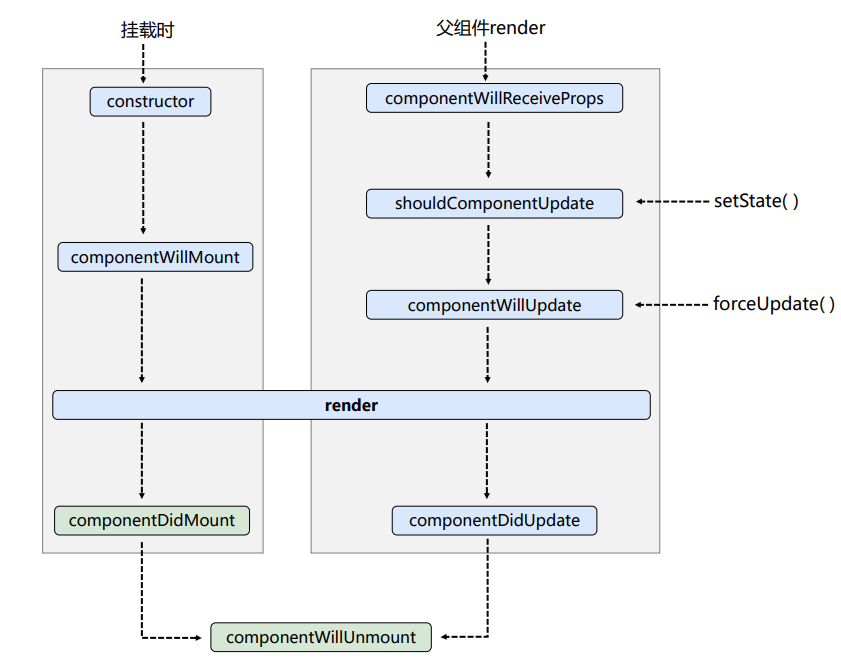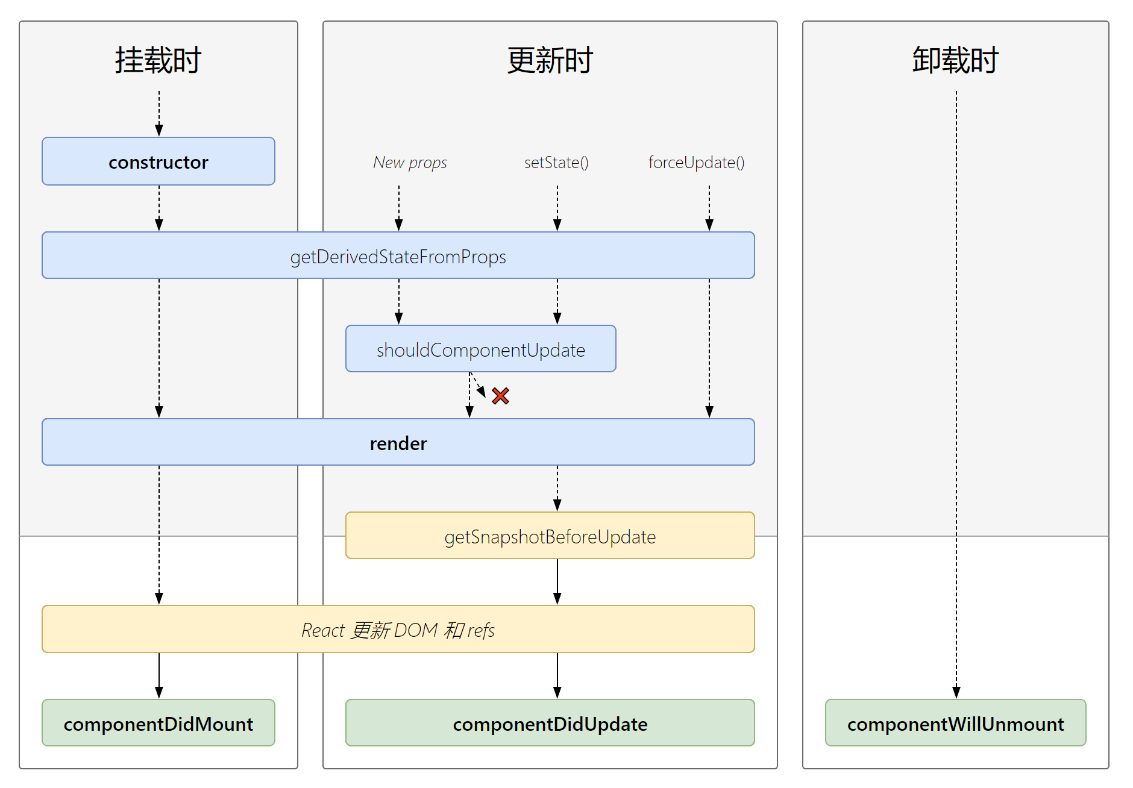React 基本使用
React Hello Wrold
html
<!-- 此处一定要写babel -->
<script type="text/babel">
//1.创建虚拟DOM
const VDOM = <h1>Hello,React</h1>;
//2.渲染虚拟DOM到页面
ReactDOM.render(VDOM, document.getElementById("app"));
</script>虚拟 DOM 的两种创建方式
JSX 创建
jsx 语法规则:
- 标签中混入 JS 表达式时要用
{}。 - 样式的类名指定不要用 class,要用 className。
- 内联样式,要用双括号包裹 key:value 的形式去写
- 只有一个根标签
- 标签必须闭合
- 标签首字母,若
小写字母开头,则将该标签转为 html 中同名元素,若 html 中无该标签对应的同名元素,则报错。若大写字母开头,react 就去渲染对应的组件,若组件没有定义,则报错
jsx
//1.创建虚拟DOM
const VDOM = (
<h1 id="title">
<span>Hello,React</span>
</h1>
);
//2.渲染虚拟DOM到页面
ReactDOM.render(VDOM, document.getElementById("app"));JS 创建
js
//1.创建虚拟DOM
const VDOM = React.createElement(
"h1",
{ id: "title" },
React.createElement("span", {}, "Hello,React")
);
//2.渲染虚拟DOM到页面
ReactDOM.render(VDOM, document.getElementById("app"));函数式组件 和 类式组件
函数式组件
jsx
function MyComponent() {
//此处的this是undefined,因为babel编译后开启了严格模式
console.log(this);
return <h2>我是创建函数式组件</h2>;
}
ReactDOM.render(<MyComponent />, document.getElementById("app"));类式组件
jsx
class MyComponent extends React.Component {
//render 在 MyComponent 的原型对象上,供实例使用
render() {
//render中的this 指向 MyComponent的实例对象
console.log("render中的this:", this);
return <h2>我是类式组件</h2>;
}
}
ReactDOM.render(<MyComponent />, document.getElementById("app"));组件实例属性 state、props、refs
state
注意点:
this 的指向可以在 constructor 中用 bind 改变指向,也可以在类上面通过 fn = 箭头函数的形式修改render 更新需要通过 调用 setState 更新更新 state
jsx
class Weather extends React.Component {
render() {
const { isHot, wind } = this.state;
return (
<h1 onClick={this.changeWeather}>
今天天气很{isHot ? "炎热" : "凉爽"},{wind}
</h1>
);
}
changeWeather = () => {
const isHot = this.state.isHot;
this.setState({ isHot: !isHot });
};
}props
- 注意 props 的传入方式,如何限制类型,以及如何函数式如何使用
jsx
class Person extends React.Component {
// 2. props类型检查
//对标签属性进行类型、必要性的限制
static propTypes = {
name: PropTypes.string.isRequired,
sex: PropTypes.string,
age: PropTypes.number,
};
// 2. props 默认值
//指定默认标签属性值
static defaultProps = {
sex: "男",
age: 18,
};
render() {
// 1. props基本使用
const { name, age, sex } = this.props;
return (
<ul>
<li>姓名:{name}</li>
<li>性别:{sex}</li>
<li>年龄:{age + 1}</li>
</ul>
);
}
}
// 3. props限制的另外一种写法
// 对标签属性进行类型、必要性的限制
// Person.propTypes = {
// name: PropTypes.string.isRequired,
// sex: PropTypes.string,
// age: PropTypes.number,
// speak: PropTypes.func, //限制speak为函数
// };
//指定默认标签属性值
// Person.defaultProps = {
// sex: "男",
// age: 18,
// };
ReactDOM.render(
// props 传入方式1
<Person name="jerry" age={19} sex="男" />,
document.getElementById("app1")
);
const p = { name: "老刘", age: 18, sex: "女" };
// props 传入方式2
ReactDOM.render(<Person {...p} />, document.getElementById("app2"));- 函数式组件用法
jsx
function Person(props) {
const { name, age, sex } = props;
return (
<ul>
<li>姓名:{name}</li>
<li>性别:{sex}</li>
<li>年龄:{age}</li>
</ul>
);
}
Person.propTypes = {
name: PropTypes.string.isRequired,
sex: PropTypes.string,
age: PropTypes.number,
};
//指定默认标签属性值
Person.defaultProps = {
sex: "男", //sex默认值为男
age: 18, //age默认值为18
};refs
jsx
class Demo extends React.Component {
myRef = React.createRef();
showData = () => {
// 1. 字符串形式的ref使用
const { input1 } = this.refs;
// 2. 回调函数形式的ref
const { input2 } = this;
// 3. createRef的使用
this.myRef.current;
};
render() {
return (
<div>
{/* 1. 字符串形式的ref */}
<input ref="input1" type="text" placeholder="点击按钮提示数据" />
{/* 回调函数形式的ref */}
<input
ref={(c) => (this.input2 = c)}
type="text"
placeholder="点击按钮提示数据"
/>
<input ref={this.myRef} type="text" placeholder="点击按钮提示数据" />
<button onClick={this.showData}>点我提示左侧的数据</button>
</div>
);
}
}组件的生命周期
旧的生命周期
- 初始化阶段: 由 ReactDOM.render()触发---初次渲染
- constructor()
- componentWillMount()
- render()
- componentDidMount()
常用一般在这个钩子中做一些初始化的事
- 更新阶段: 由组件内部 this.setSate()或父组件 render 触发
- shouldComponentUpdate()
- componentWillUpdate()
- render()
- componentDidUpdate()
- 卸载组件: 由 ReactDOM.unmountComponentAtNode()触发
- componentWillUnmount()
常用一般在这个钩子中做一些收尾的事
- componentWillUnmount()

新的生命周期
- 初始化阶段: 由 ReactDOM.render()触发---初次渲染
- constructor()
getDerivedStateFromProps若 state 的值在任何时候都取决于 props,那么可以使用 getDerivedStateFromProps- render()
- componentDidMount() =====> 常用 一般在这个钩子中做一些初始化的事
- 更新阶段: 由组件内部 this.setSate()或父组件重新 render 触发
getDerivedStateFromProps- shouldComponentUpdate()
- render()
getSnapshotBeforeUpdate在更新之前获取快照,返回值可以在 componentDidUpdate 第三个参数中获取到- componentDidUpdate()
- 卸载组件: 由 ReactDOM.unmountComponentAtNode()触发
- componentWillUnmount() =====> 常用一般在这个钩子中做一些收尾的事

路由组件的 lazyLoad
js
//1.通过React的lazy函数配合import()函数动态加载路由组件 ===> 路由组件代码会被分开打包
const Login = lazy(()=>import('@/pages/Login'))
//2.通过 <Suspense> 指定在加载得到路由打包文件前显示一个自定义loading界面
<Suspense fallback={<h1>loading.....</h1>}>
<Switch>
<Route path="/xxx" component={Xxxx}/>
<Redirect to="/login"/>
</Switch>
</Suspense>